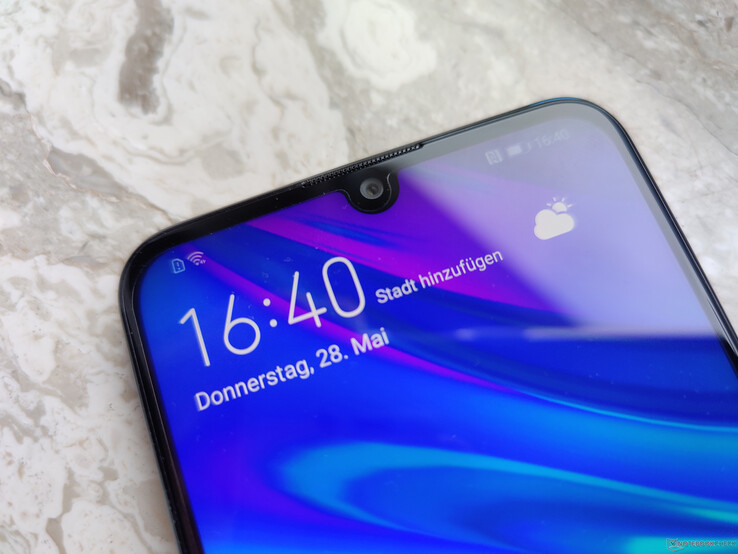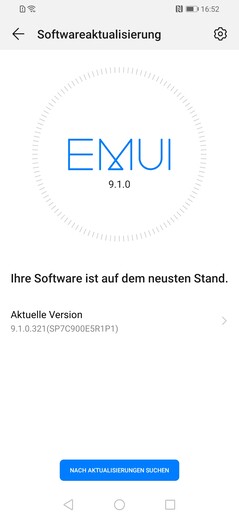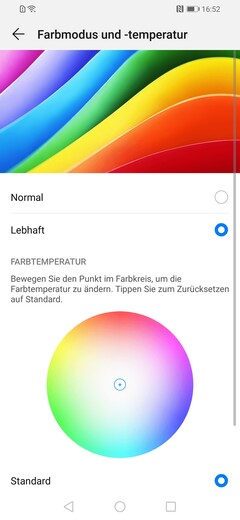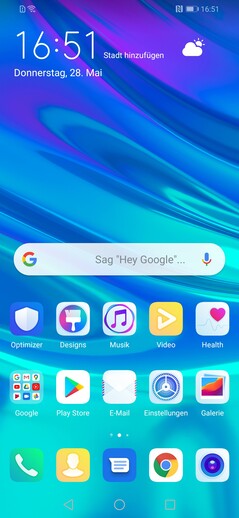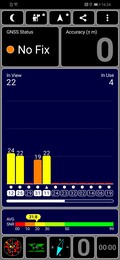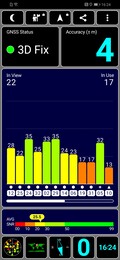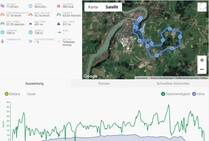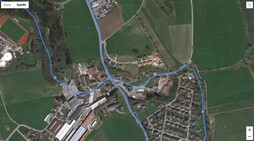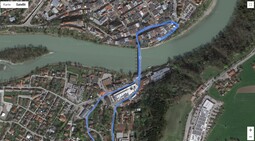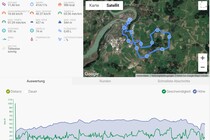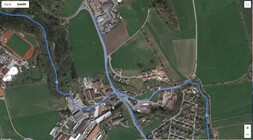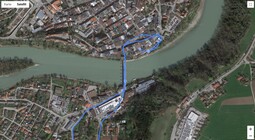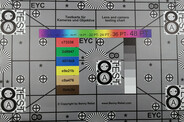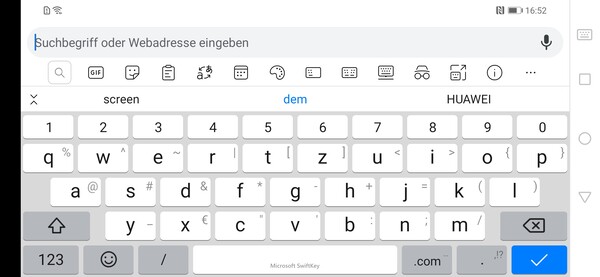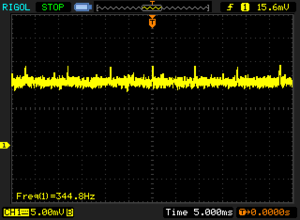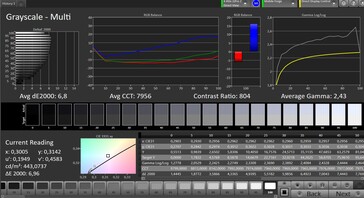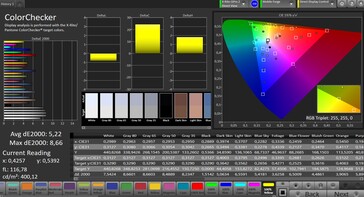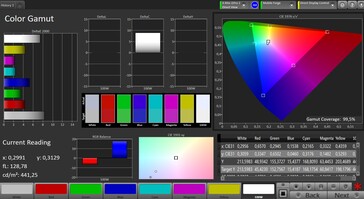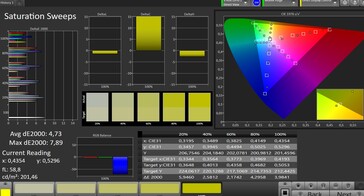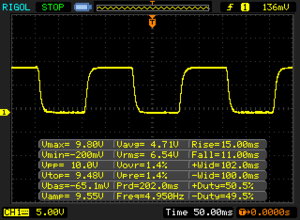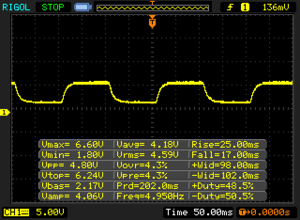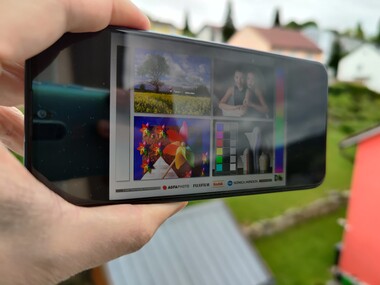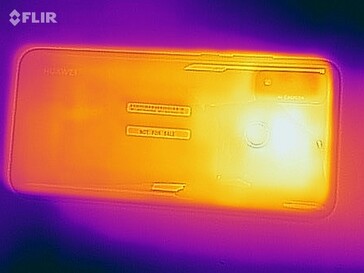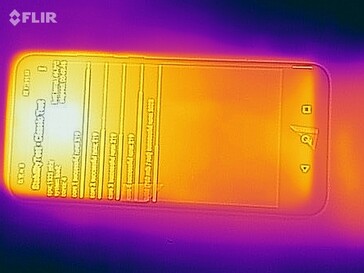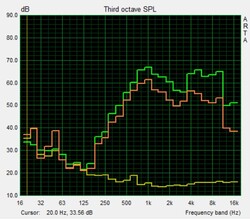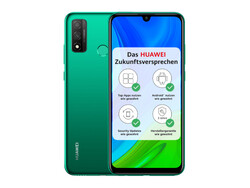Huawei P Smart 2020 incelemesi - Rahat ve eski
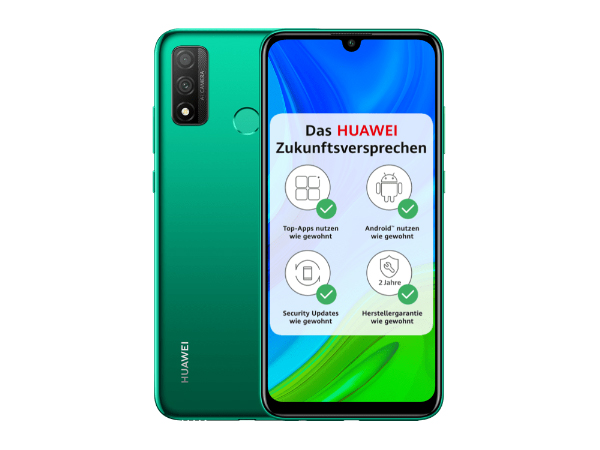
Huawei'yi gerçekten anlayabilirsiniz ve Çinli üreticinin umutsuzluğa girmeye başladığı: Amerikan teknolojisi yasağı nedeniyle, üreticinin artık Google Hizmetlerine erişimi yok. Bu aynı zamanda yeni modeller için sertifikasyonu zor hatta imkansız hale getirir. Bir yıl öncesine kadar akıllıca kaplanabilecek şey artık Huawei P Smart 2020'de oldukça açık hale geliyor: Huawei eski modelleri basitçe yeniden yayınlamaya başladı ve sadece yeni bir sertifikanın hala gerekli olmayacağı kadar değişti. Huawei P Smart 2019 popüler bir akıllı telefondu, bu yüzden Huawei, halefte çok fazla değişmezse o kadar da kötü değil, değil mi? Bunu testimizde tam olarak öğrenmek istiyoruz. Not: Bazı ölçütleri yükleme sorunları nedeniyle Huawei'den ek bir test birimi istedik. Huawei P Smart 2020'de ek test sonuçları alır almaz bu testi güncelleyeceğiz.
Comparison Devices
Derecelendirme | Tarih | Modeli | Ağırlık | Sürücü | Boyut | Çözünürlük | Fiyat |
|---|---|---|---|---|---|---|---|
| 76.6 % v7 (old) | 06/2020 | Huawei P Smart 2020 Kirin 710, Mali-G51 MP4 | 163 g | 128 GB eMMC Flash | 6.21" | 2340x1080 | |
| 75.7 % v7 (old) | 06/2020 | Nokia 5.3 SD 665, Adreno 610 | 185 g | 64 GB eMMC Flash | 6.55" | 1600x720 | |
| 80.7 % v7 (old) | 06/2020 | Xiaomi Redmi Note 9S SD 720G, Adreno 618 | 209 g | 128 GB UFS 2.0 Flash | 6.67" | 2400x1080 | |
| 76.6 % v7 (old) | 06/2020 | Motorola Moto G8 SD 665, Adreno 610 | 188 g | 64 GB eMMC Flash | 6.40" | 1560x720 | |
| 84.9 % v6 (old) | 01/2019 | Huawei P Smart 2019 Kirin 710, Mali-G51 MP4 | 160 g | 64 GB eMMC Flash | 6.20" | 2340x1080 |
Kasa - Hafif plastik kasa
Top 10
» Top 10 Multimedia Notebook listesi
» Top 10 oyun notebooku
» Top 10 bütçeye uygun Ofis/İş Notebook Listesi
» Top 10 Premium Ofis/İş notebookları
» Top 10 Çalışma istasyonu laptopları
» Top 10 Subnotebook listesi
» Top 10 Ultrabooklar
» En iyi 10 dönüştürülebilir modeli
» Seçimi en iyi 10 tablet
» Notebookcheck Top 10 Windows Tabletleri
» Top 10 Subnotebook listesi
» NotebookCheck tarafından incelenen en iyi Notebook ekranları
» Notebookcheck'in 500 Euro altındaki en iyi 10 Notebook listesi
» NotebookCheck tarafından seçilen 300 Euro altındaki en iyi 10 Notebook
» Notebookcheck'in 500 Euro altındaki en iyi 10 Notebook listesi
» Notebookcheck'in Top 10 akıllı telefon listesi
» Notebookcheck'in Top 10 hafif oyun notebookları
Zümrüt Yeşili ile P Smart 2020 için selefinin sahip olmadığı yeni bir renk var, aksi takdirde Aurora Blue ve Midnight Black bilinen varyasyonlar. Her iki model için de mevcut olan bu renklerde P Smart 2020'nin dışı, 2019'dan itibaren P Smart'a çok benziyor. Sadece kamera modülü Huawei'nin mevcut tasarımına güncellendi ve gerçekten de daha yüksek bir kaliteye sahip görünüyor. selefi. P Smart 2020, elbette öncelikle küçük pilinden dolayı oldukça ince ve hafif bir akıllı telefon. Ancak, bu yön mevcut akıllı telefonları çok büyük ve ağır bulanlar için hala ilginç olabilir. Akıllı telefon ele rahatça oturur, oldukça sağlam bir yapıya sahiptir ve bükmeye çalışırken sadece sessizce kırışır. Akıllı telefon, öndeki veya arkadaki basınca neredeyse hiç tepki vermiyor. Bununla birlikte, kullanmaya başladıktan kısa bir süre sonra, ışık sağa çarptığında ve parmak izleri de hızlı bir şekilde görünür hale geldiğinde kasa üzerinde bazı minimum çizikler görebilirsiniz. Ancak en azından ekran koruyucusu öncekinden daha iyi yerleştirildi ve günlük kullanımda zorlukla görüyor veya hissedebiliyorsunuz.
Ekipman - Huawei'nin daha fazla depolama alanı var
128 GB depolama alanı ile Huawei P Smart 2020, öncekinden daha iyi bir donanıma sahip ve buradaki fiyat sınıfındaki diğer cihazlara bir avantaj sağlıyor. Ayrıca şu anda 4 GB çalışma belleği var ve depolama alanını genişletmek için bir microSD kart kullanabilirsiniz, ancak daha sonra iki SIM yuvasından biri dolu olacaktır.NFC, temassız ödemeler için Google Pay'ı kullanmanızı sağlar. misal. USB-C artık uygun fiyatlı cihazlarda bile daha sık kullanılabilir olmasına ve kesinlikle standart haline gelmesine rağmen, hala sadece bir mikro USB bağlantısı olması çok kötü.
Yazılım - Android 9? Doğru okudunuz!
Huawei P Smart 2020'nin hala selefi gibi Android 9 ile birlikte geldiği doğrudur, bu nedenle Google'ın işletim sisteminin eski bir sürümünü ve Huawei'nin şirket içi kullanıcı arabirimi olan ilgili EMUI 9'u kullanır. Güvenlik yamaları Şubat 2020'den beri, bu yüzden testlerimizde zaten yaşlanmışlar. Can sıkıcı: Huawei'nin EMUI 9'u Android 9'a dayandığından, tüm arka planları karanlık gösteren sistem için Karanlık Mod yoktur. Ayrıca, birkaç uygulama yüklerken bazı sorunlar yaşadık, ancak nedenlerini doğrulayamadık. Tüm izinleri ayarlamış olsak da uygulamalar APK'lardan yüklenemedi ve Google Play Store'daki bazı uygulamaların da yüklemeyle ilgili bazı sorunları vardı. Muhtemelen bunun nedeni test birimimizdi, bu yüzden Huawei'den başka bir cihaz istedi. Gerekirse bu testi güncelleyeceğiz. En azından Huawei herhangi bir üçüncü taraf uygulaması yüklemez, ancak yalnızca bazıları da kaldırılabilen ücretsiz araçlarla kapsamlı bir şirket içi uygulama paketi yükler. Arkadaş gruplarında birkaç Huawei ve / veya Honor akıllı telefonu olanlar, bunları bir Parti modu ile bağlayabilir ve birkaç hoparlöre sahip bir ses sistemine sahip olmak gibi tüm cihazlarda aynı müziği çalabilir.
İletişim ve GPS - Birkaç LTE bandı
LTE Cat.6 ile maksimum LTE hızı fiyat sınıfı için uygundur, ancak sadece gerekli minimum LTE frekans bantları desteklenir, böylece yurtdışına seyahat ederken mobil İnternet kullanmak zorlaşabilir. Huawei P Smart 2020'nin alımı iç mekanlarda oldukça iyi ve çoğu zaman şehir çevresinde tam olarak resepsiyon aldık. WLAN açısından Wi-Fi 5 desteklenmektedir. Bu gerçekten bu fiyat sınıfı için alışılmış, ancak yine de benzer miktarda para için bazı daha yavaş modeller var. P Smart 2020, hızlarına kadar selefinin seviyesindedir ve Netgear Nighthawk AX12 referans yönlendiricimizle iletişimde biraz tutarsız veri hızları gösterir.
| Networking | |
| iperf3 transmit AX12 | |
| Xiaomi Redmi Note 9S | |
| Huawei P Smart 2019 | |
| Huawei P Smart 2020 | |
| Nokia 5.3 | |
| Motorola Moto G8 | |
| iperf3 receive AX12 | |
| Xiaomi Redmi Note 9S | |
| Huawei P Smart 2020 | |
| Huawei P Smart 2019 | |
| Nokia 5.3 | |
| Motorola Moto G8 | |
Beidou, GLONASS ve GPS konum belirleme için desteklenen uydu şebekeleridir. İçeride, eğer varsa, yerleştirme sadece pencerelerin yakınında ve hatta yaklaşık olarak mümkündür. Bununla birlikte, dış mekanda konum doğruluğu hızlı bir şekilde dört metreye kadar çıkar. Pratik testimiz bize Huawei akıllı telefonun konum doğruluğu hakkında daha fazla bilgi verir. Bunun için bisikletimize atlıyoruz ve ayrıca karşılaştırma için Garmin Edge 520 profesyonel navigasyon cihazını alıyoruz. İlk bakışta, Huawei akıllı telefon şikayet için fazla bir neden vermiyor. Yer belirleme oldukça doğrudur ve bazı küçük turları göz ardı ederseniz rotaya sadık kalırsınız. Ancak, kavşak görüntüsünün üstünde görebileceğiniz gibi, rotayı kaydederken ortada bir düşüş var. Genel olarak, mutlak doğruluk çok önemli değilse ve bazı nadir bırakmalarla da yaşayabiliyorsanız akıllı telefonu navigasyon için kullanabilirsiniz.
Telefon İşlevleri ve Ses Kalitesi - İyi ses üretimi ile P Smart
Huawei'nin kendi Telefon uygulaması Google'ın standart uygulamasından biraz farklıdır, ancak kullanımı da kolaydır ve hızlı bir şekilde öğrenilebilir. Menüde Wi-Fi ile Arama veya VoLTE için bir seçenek görmedik.Dahili kulaklığı kullanan ses kalitesi oldukça iyi. Maksimum ses seviyesinde, konuşma ortağımızın sesi hafifçe patlar, ancak aksi takdirde ses çıkar ve oldukça sıcaktır. Ne kadar sessiz veya yüksek sesle konuşsak konuşalım, kendi sesimiz de iyi aktarılıyor. Ses kalitesi de hoparlör kullanılarak oldukça iyidir ve kendi sesimiz mikrofon tarafından net bir şekilde kaydedilir.
Kameralar - Yalnızca tek bir fotoğraf lensi
Evet, Huawei P Smart 2020'de çift kamera var, ancak hayır, birkaç odak mesafesine sahip bir zoom kamera değil. İkinci mercek sadece derinlik keskinliğini belirlemek için iyidir, bu nedenle fotoğraf çekmek için kullanılmaz. 13 megapiksel çözünürlükte, ana kamera öncekiyle aynı özellikleri sunuyor. İyi fotoğraflar çeker, ancak ayrıntılar hızla soluk görünür ve diğer akıllı telefon kameralarında kontrast da daha yüksektir. Düşük ışıkta çekilen görüntüler netliği hızla kaybederken, parlaklık oldukça iyidir.Genel olarak, ana kamera ile makul resimler çekebilirsiniz. Bununla birlikte, P Smart 2020, bu fiyat aralığındaki diğer akıllı telefonlar tarafından sunulan bir zoom kameranın esnekliğine sahip değildir. Bir yandan, kamera uygulaması çok geniştir ve birçok işlev sunar. Öte yandan, örneğin yalnızca otomatik olarak en iyi ayarlara ayarlanan AI kamerayı 8 megapiksel görüntü boyutunda kullanabilirsiniz. Videolar maksimum 1080p ve 30 fps'de kaydedilebilir. Görüntü kalitesi iyi ve zayıf ışık koşullarında parlaklık hala iyi. Önde bir su damlası çentiği içinde, öncekinden zaten bilinen 8 megapiksel bir ön kamera var. Bununla birlikte servis yapılabilir selfie'ler de alabilirsiniz. Kamera, görüntüdeki parlaklık farklarıyla oldukça iyi sonuç verir ve en azından küçük büyütme boyutlarında iyi bir keskinlik sunar.
Görüntü Karşılaştırma
Bir sahne seçin ve ilk görüntüde gezinin. Tek bir tıklama dokunmatik ekranlardaki konumu değiştirir. Yakınlaştırılmış görüntüye tek tıklamayla orijinal yeni bir pencerede açılır. İlk resimde test cihazının ölçekli fotoğrafı gösterilmektedir.
Scene 1Scene 2Scene 3
Test laboratuvarımızdaki kontrollü ışık koşullarında, ana kamera iyi renk üretimi ve kontrastı gösterir. Ancak, neredeyse hiç ışık yoksa, lens artık hiçbir şeyi tanıyamaz.
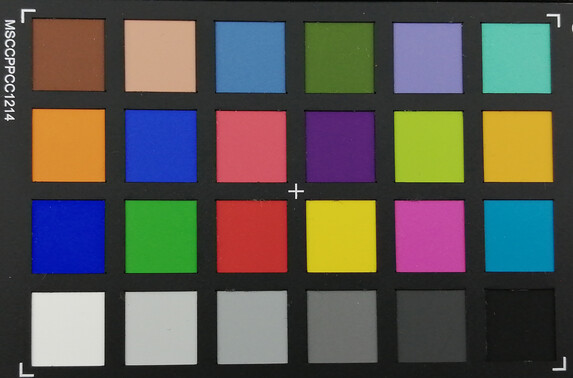

Aksesuarlar ve Garanti - İki yıl boyunca güvenlik
Akıllı telefonun yanı sıra kutuda şarj cihazı, USB kablosu ve SIM aracı da bulunuyor. Huawei, oldukça kabul edilebilir bir ses sunan kablolu bir kulaklık da içeriyor.Üretici, akıllı telefonda 24 ay garanti sunuyor.
Giriş Aygıtları ve Çalışması - Arkada bir parmak izi sensörü
Dokunmatik ekran her yerde kolayca çalıştırılabilir ve köşelerde de hassastır. Sistem birçok durumda sorunsuz çalışma için yeterince hızlıdır ve sadece küçük zamanlar veya bekleme süreleri yalnızca zaman zaman oluşur.WiftKey klavye uygulaması olarak kullanılır ve hoşlanmayanlar da başka bir uygulama yükleyebilir. Bununla birlikte, bunu yaparken, kime güvendiğinize dikkat etmelisiniz, çünkü bir klavye uygulaması üreticisi tüm girişlerinizi potansiyel olarak okuyabilir. Bu, örneğin yazım denetimi için sunucuya aktarıldıklarında parolaları içerir. Arkadaki parmak izi sensörü, cihazın kilidini hafif bir gecikmeyle açar, ancak çok güvenilirdir.
Display - Huawei with mediocre brightness
The display offers an expanded Full HD resolution, which is a good thing for this price range but not completely unusual. The display is based on IPS technology. The measurements for the brightness remind us of the predecessor, and at 448 cd/m² on average, they are at a rather low level. The brightness distribution is fairly even.
| |||||||||||||||||||||||||
Aydınlatma: 87 %
Batarya modunda parlaklık: 446 cd/m²
Kontrast: 875:1 (Siyah: 0.51 cd/m²)
ΔE ColorChecker Calman: 5.22 | ∀{0.5-29.43 Ø4.77}
ΔE Greyscale Calman: 6.8 | ∀{0.09-98 Ø5}
99.5% sRGB (Calman 2D)
Gamma: 2.43
CCT: 7956 K
| Huawei P Smart 2020 IPS, 2340x1080, 6.2" | Nokia 5.3 IPS, 1600x720, 6.6" | Xiaomi Redmi Note 9S IPS, 2400x1080, 6.7" | Motorola Moto G8 IPS, 1560x720, 6.4" | Huawei P Smart 2019 IPS, 2340x1080, 6.2" | |
|---|---|---|---|---|---|
| Screen | 1% | 22% | 35% | 34% | |
| Brightness middle (cd/m²) | 446 | 523 17% | 622 39% | 504 13% | 458 3% |
| Brightness (cd/m²) | 448 | 482 8% | 612 37% | 452 1% | 440 -2% |
| Brightness Distribution (%) | 87 | 86 -1% | 94 8% | 83 -5% | 85 -2% |
| Black Level * (cd/m²) | 0.51 | 0.46 10% | 0.56 -10% | 0.28 45% | 0.35 31% |
| Contrast (:1) | 875 | 1137 30% | 1111 27% | 1800 106% | 1309 50% |
| Colorchecker dE 2000 * | 5.22 | 6.22 -19% | 3.98 24% | 3.84 26% | 1.4 73% |
| Colorchecker dE 2000 max. * | 8.66 | 10.56 -22% | 7.33 15% | 6.1 30% | 3.8 56% |
| Greyscale dE 2000 * | 6.8 | 8 -18% | 4.5 34% | 2.7 60% | 2.4 65% |
| Gamma | 2.43 91% | 2.226 99% | 2.206 100% | 2.235 98% | 2.22 99% |
| CCT | 7956 82% | 8856 73% | 7361 88% | 7125 91% | 6235 104% |
| Color Space (Percent of sRGB) (%) | 114.9 |
* ... daha küçük daha iyidir
Ekran Titremesi / PWM (Darbe Genişliği Modülasyonu)
| Ekran titriyor / PWM algılandı | 344 Hz | ≤ 10 % parlaklık ayarı | |
Ekran arka ışığı 344 Hz'de titriyor (en kötü durum, örneğin PWM kullanılması) 10 % ve altındaki parlaklık ayarında titreme algılandı. Bu parlaklık ayarının üzerinde titreme veya PWM olmamalıdır. 344 Hz frekansı nispeten yüksektir, bu nedenle PWM'ye duyarlı çoğu kullanıcı herhangi bir titremeyi fark etmemelidir. Ancak bazı kullanıcıların 500 Hz ve üzeri PWM'ye hâlâ duyarlı olduğuna dair raporlar var, bu nedenle dikkatli olun. Karşılaştırıldığında: Test edilen tüm cihazların %53 %'si ekranı karartmak için PWM kullanmıyor. PWM tespit edilirse, ortalama 8091 (minimum: 5 - maksimum: 343500) Hz ölçüldü. | |||
At 0.51 cd/m², the black value is only average, and at high brightness dark areas appear more dark gray than black. Colors are also not that vibrant, which you can see in the low contrast value.
The measurements with the CalMAN software and the spectral photometer show that the display has a strong blue tint. However, you can adjust the white balance fairly extensively in the settings, allowing you to bring the display closer to your personal needs and tastes.
Yanıt Sürelerini Görüntüle
| ↔ Tepki Süresi Siyahtan Beyaza | ||
|---|---|---|
| 26 ms ... yükseliş ↗ ve sonbahar↘ birleşimi | ↗ 15 ms yükseliş | |
| ↘ 11 ms sonbahar | ||
| Ekran, testlerimizde nispeten yavaş yanıt oranları gösteriyor ve oyuncular için çok yavaş olabilir. Karşılaştırıldığında, test edilen tüm cihazlar 0.1 (minimum) ile 240 (maksimum) ms arasında değişir. » Tüm cihazların 61 %'si daha iyi. Bu, ölçülen yanıt süresinin test edilen tüm cihazların ortalamasından (20.2 ms) daha kötü olduğu anlamına gelir. | ||
| ↔ Tepki Süresi %50 Griden %80 Griye | ||
| 42 ms ... yükseliş ↗ ve sonbahar↘ birleşimi | ↗ 25 ms yükseliş | |
| ↘ 17 ms sonbahar | ||
| Ekran, testlerimizde yavaş yanıt oranları gösteriyor ve oyuncular için yetersiz olacaktır. Karşılaştırıldığında, test edilen tüm cihazlar 0.165 (minimum) ile 636 (maksimum) ms arasında değişir. » Tüm cihazların 66 %'si daha iyi. Bu, ölçülen yanıt süresinin test edilen tüm cihazların ortalamasından (31.6 ms) daha kötü olduğu anlamına gelir. | ||
Outdoors, the display has some visible difficulties. While on cloudy days, its brightness is sufficient, you should look for a shady place on sunny days. The viewing angles are fairly decent, and there are only slight brightness differences when you look at the display from the side. The display contents always remain easily recognizable.
Performance - We already know the SoC from before
The HiSilicon Kirin 710 is the SoC that is currently used in probably most of the smartphones from Huawei and Honor. While the processor is still fairly fast even in 2020, you do notice that technology has advanced at this point. Huawei will have to think about something new next year for sure, in order to be able to keep up. However, currently it is still sufficient for fairly smooth operation with some smaller stutters under high loads.
In terms of the graphics, the smartphone is currently also able to still keep up, but the Xiaomi Redmi Note 9S already offers more power.
| VRMark - Amber Room (değere göre sırala) | |
| Huawei P Smart 2020 | |
| Xiaomi Redmi Note 9S | |
| Ortalama HiSilicon Kirin 710 (961 - 1146, n=3) | |
In terms of its surf speeds, the Huawei P Smart 2020 places in the middle of the field of test devices. In practice, this means that you have to live with some load times for websites, particularly with images. However, the Huawei smartphone is well-suited overall for surfing.
| Jetstream 2 - 2.0 Total Score | |
| Sınıf ortalaması Smartphone (23.8 - 387, n=148, son 2 yıl) | |
| Xiaomi Redmi Note 9S (Chrome 81) | |
| Ortalama HiSilicon Kirin 710 (30 - 33, n=8) | |
| Huawei P Smart 2020 (Chrome 81) | |
| Motorola Moto G8 (Chrome 81) | |
| JetStream 1.1 - Total Score | |
| Xiaomi Redmi Note 9S (Chrome 81) | |
| Huawei P Smart 2020 (Chrome 81) | |
| Ortalama HiSilicon Kirin 710 (47 - 55.1, n=10) | |
| Huawei P Smart 2019 (Chrome 70) | |
| Motorola Moto G8 (Chrome 81) | |
| Speedometer 2.0 - Result 2.0 | |
| Sınıf ortalaması Smartphone (15.2 - 643, n=121, son 2 yıl) | |
| Xiaomi Redmi Note 9S (Chome 81) | |
| Ortalama HiSilicon Kirin 710 (30.4 - 33.9, n=6) | |
| Huawei P Smart 2020 (Chome 81) | |
| Motorola Moto G8 (Chome 81) | |
| WebXPRT 3 - Overall | |
| Sınıf ortalaması Smartphone (38 - 380, n=31, son 2 yıl) | |
| Huawei P Smart 2019 (Chrome 70) | |
| Xiaomi Redmi Note 9S (Chrome 81) | |
| Huawei P Smart 2020 (Chrome 81) | |
| Ortalama HiSilicon Kirin 710 (52 - 69, n=11) | |
| Motorola Moto G8 (Chrome 81) | |
| Octane V2 - Total Score | |
| Sınıf ortalaması Smartphone (2228 - 121337, n=195, son 2 yıl) | |
| Xiaomi Redmi Note 9S (Chrome 81) | |
| Huawei P Smart 2019 (Chrome 70) | |
| Huawei P Smart 2020 (Chrome 81) | |
| Ortalama HiSilicon Kirin 710 (9041 - 10544, n=13) | |
| Motorola Moto G8 (Chrome 81) | |
| Mozilla Kraken 1.1 - Total | |
| Motorola Moto G8 (Chrome 81) | |
| Ortalama HiSilicon Kirin 710 (3999 - 4853, n=13) | |
| Huawei P Smart 2020 (Chrome 81) | |
| Huawei P Smart 2019 (Chrome 70) | |
| Xiaomi Redmi Note 9S (Chrome 81) | |
| Sınıf ortalaması Smartphone (257 - 28190, n=154, son 2 yıl) | |
* ... daha küçük daha iyidir
The storage has only increased and has not become any faster. It is still the slow eMMC flash type, which is still fairly widespread in this price range. While you have to live with some longer wait times when starting apps, overall the data is mostly made available smoothly.
The microSD card reader can handle our Toshiba Exceria Pro M501 quite well and offers good data rates.
| Huawei P Smart 2020 | Nokia 5.3 | Xiaomi Redmi Note 9S | Motorola Moto G8 | Huawei P Smart 2019 | Ortalama 128 GB eMMC Flash | Sınıf ortalaması Smartphone | |
|---|---|---|---|---|---|---|---|
| AndroBench 3-5 | 31% | 70% | 27% | 7% | 20% | 694% | |
| Sequential Read 256KB (MB/s) | 282.1 | 299.5 6% | 496.6 76% | 301 7% | 288.3 2% | 300 ? 6% | 2243 ? 695% |
| Sequential Write 256KB (MB/s) | 168.3 | 243.2 45% | 214.8 28% | 239 42% | 191.4 14% | 195.1 ? 16% | 1865 ? 1008% |
| Random Read 4KB (MB/s) | 41.2 | 109.1 165% | 137 233% | 57.3 39% | 45.66 11% | 85.9 ? 108% | 296 ? 618% |
| Random Write 4KB (MB/s) | 61.1 | 45.2 -26% | 123.6 102% | 128.1 110% | 70.7 16% | 58.1 ? -5% | 339 ? 455% |
| Sequential Read 256KB SDCard (MB/s) | 76.1 ? | 77.3 ? 2% | 74.5 ? -2% | 68.7 ? -10% | 76.2 ? 0% | 78.1 ? 3% | |
| Sequential Write 256KB SDCard (MB/s) | 67 ? | 60.7 ? -9% | 54.9 ? -18% | 48.7 ? -27% | 66.9 ? 0% | 61.8 ? -8% |
Games - Not always 30 fps
Gaming is possible on the Huawei P Smart 2020 but not always in smooth 30 fps. From time to time, the frame rate drops down to 20 fps, which can become noticeable as a slight stutter. But this goes for the more demanding games that we test, and simple games such as Angry Birds run smoothly. We determine the frame rates with the tools from GameBench.
The control via position sensor and touchscreen also works without any problems.
Emissions - A hot Huawei smartphone
Temperature
While under longer lasting, higher load, the Huawei P Smart 2020 becomes noticeably warm, but it does not reach any critical or uncomfortable temperatures. Unfortunately, GFXBench refuses to run on the smartphone, so that we are unable to test the performance stability under longer load and also cannot make any determination on throttling of the performance.
Because of the differences in heat development between the P Smart 2019 and P Smart 2020, we could think of several scenarios: Either Huawei raised the thermal limit for throttling on purpose, making more power available but also causing more heat to develop or Huawei has simply changed the internal design slightly, causing heat to become more trapped.
However, during our benchmarks, we do not see any significant performance differences between the two smartphones, so that we can come to the conclusion that the Huawei P Smart 2020 heats up more than its predecessor while offering the same performance.
(±) Üst taraftaki maksimum sıcaklık, 35.2 °C / 95 F ortalamasına kıyasla 44.3 °C / 112 F'dir. , Smartphone sınıfı için 21.9 ile 247 °C arasında değişir.
(-) Alt kısım, 34 °C / 93 F ortalamasına kıyasla maksimum 45.3 °C / 114 F'ye kadar ısınır
(+) Boşta kullanımda, üst tarafın ortalama sıcaklığı 28.5 °C / 83 F olup, cihazın 32.9 °C / 91 F.
Speaker
The speaker on the bottom edge does not become extremely loud, but it offers a fairly balanced sound, particularly for such an affordable device. Songs or voices can be heard and understood easily. Of course, the speaker will only remain an emergency solution for those who like to listen to music, but at least the Huawei P Smart 2020 sounds better than some other smartphones.
Audio devices can be connected via Bluetooth and 3.5-mm audio port, which works without any problems, and the transferred sound is also clean.
Huawei P Smart 2020 ses analizi
(±) | hoparlör ses yüksekliği ortalama ama iyi (74.8 dB)
Bas 100 - 315Hz
(-) | neredeyse hiç bas yok - ortalama olarak medyandan 24.9% daha düşük
(±) | Bas doğrusallığı ortalamadır (11.2% delta - önceki frekans)
Ortalar 400 - 2000 Hz
(±) | daha yüksek ortalar - ortalama olarak medyandan 5.9% daha yüksek
(±) | Ortaların doğrusallığı ortalamadır (8% delta - önceki frekans)
Yüksekler 2 - 16 kHz
(±) | daha yüksek en yüksekler - ortalama olarak medyandan 5.5% daha yüksek
(+) | yüksekler doğrusaldır (6.5% deltadan önceki frekansa)
Toplam 100 - 16.000 Hz
(±) | Genel sesin doğrusallığı ortalamadır (27.7% ortancaya göre fark)
Aynı sınıfla karşılaştırıldığında
» Bu sınıftaki tüm test edilen cihazların %72%'si daha iyi, 5% benzer, 23% daha kötüydü
» En iyisinin deltası 11% idi, ortalama 35% idi, en kötüsü 134% idi
Test edilen tüm cihazlarla karşılaştırıldığında
» Test edilen tüm cihazların %84'si daha iyi, 3 benzer, % 13 daha kötüydü
» En iyisinin deltası 4% idi, ortalama 24% idi, en kötüsü 134% idi
Xiaomi Redmi Note 9S ses analizi
(±) | hoparlör ses yüksekliği ortalama ama iyi (81 dB)
Bas 100 - 315Hz
(-) | neredeyse hiç bas yok - ortalama olarak medyandan 64.7% daha düşük
(+) | bas doğrusaldır (0% delta ile önceki frekans)
Ortalar 400 - 2000 Hz
(-) | neredeyse hiç orta seviye yok - ortalama olarak medyandan 64.7% daha düşük
(+) | orta frekanslar doğrusaldır (0% deltadan önceki frekansa)
Yüksekler 2 - 16 kHz
(-) | neredeyse hiç yüksek yok - ortalama olarak medyandan 64.7% daha düşük
(+) | yüksekler doğrusaldır (0% deltadan önceki frekansa)
Toplam 100 - 16.000 Hz
(-) | genel ses doğrusal değildir (119.7% ortancaya göre fark)
Aynı sınıfla karşılaştırıldığında
» Bu sınıftaki tüm test edilen cihazların %88%'si daha iyi, 8% benzer, 3% daha kötüydü
» En iyisinin deltası 11% idi, ortalama 35% idi, en kötüsü 134% idi
Test edilen tüm cihazlarla karşılaştırıldığında
» Test edilen tüm cihazların %97'si daha iyi, 3 benzer, % 1 daha kötüydü
» En iyisinin deltası 4% idi, ortalama 24% idi, en kötüsü 134% idi
Battery Life - Short days with the Huawei smartphone
Power Consumption
The power consumption of the Huawei P Smart 2020 is minimally higher than that of the predecessor. However, the smartphone doesn't fare badly overall if you compare it with other smartphones of this price range. So the efficiency is at an acceptable level.
| Kapalı / Bekleme modu | |
| Boşta | |
| Çalışırken |
|
Key:
min: | |
| Huawei P Smart 2020 3400 mAh | Xiaomi Redmi Note 9S 5020 mAh | Motorola Moto G8 4000 mAh | Huawei P Smart 2019 3400 mAh | Ortalama HiSilicon Kirin 710 | Sınıf ortalaması Smartphone | |
|---|---|---|---|---|---|---|
| Power Consumption | -14% | -5% | 4% | -4% | -7% | |
| Idle Minimum * (Watt) | 1 | 1.5 -50% | 1.3 -30% | 0.84 16% | 1.058 ? -6% | 0.845 ? 15% |
| Idle Average * (Watt) | 2.1 | 2.1 -0% | 2 5% | 2.21 -5% | 2.2 ? -5% | 1.44 ? 31% |
| Idle Maximum * (Watt) | 2.5 | 2.5 -0% | 2.8 -12% | 2.23 11% | 2.57 ? -3% | 1.625 ? 35% |
| Load Average * (Watt) | 4.3 | 5.2 -21% | 3.9 9% | 4.2 2% | 4.61 ? -7% | 7.01 ? -63% |
| Load Maximum * (Watt) | 7.5 | 7.5 -0% | 7.2 4% | 7.86 -5% | 7.6 ? -1% | 11.3 ? -51% |
* ... daha küçük daha iyidir
Battery Life
The 3400-mAh battery is relatively small for 2020, and the predecessor has already been unable to get much out of the same-size battery. The Huawei P Smart 2020 only does a minimally better job, but with 8:43 hours in our WLAN test, it only lasts half as long as a Xiaomi Redmi Note 9S. The Motorola Moto G8 also offers a significantly longer battery life.
There is also no quick-charge feature, but since the battery is fairly small, you can still expect a full battery after less than two hours of recharging.
| Huawei P Smart 2020 3400 mAh | Nokia 5.3 4000 mAh | Xiaomi Redmi Note 9S 5020 mAh | Motorola Moto G8 4000 mAh | Huawei P Smart 2019 3400 mAh | |
|---|---|---|---|---|---|
| Pil Çalışma Süresi | 68% | 91% | 64% | -3% | |
| Reader / Idle (h) | 22.1 | 37.7 71% | 32.6 48% | 21.6 -2% | |
| H.264 (h) | 8.2 | 21.2 159% | 17.5 113% | 7.7 -6% | |
| WiFi v1.3 (h) | 8.7 | 14.6 68% | 19.8 128% | 16.5 90% | 8.4 -3% |
| Load (h) | 4.4 | 4.7 7% | 4.6 5% | 4.3 -2% |
Artılar
Eksiler
Verdict - A small update for a large price difference
Huawei's P Smart series is popular. This is understandable, because until now the series offered a lot for the money. This also makes it possible that the P Smart 2020 still feels fairly current, even though there are only few changes compared to the predecessor.
But the first signs of wear have become visible: While the camera still takes solid pictures, it lacks the capability of zooming, which is offered by many devices of this price range at this point. You will also look in vain for modern features such as a USB-C port, VoLTE, or faster LTE with more frequency bands. To introduce a smartphone with Android 9 in 2020 without it being clear that it will ever get Android 10 is also questionable.
The small battery turns out to be either a blessing or a curse, depending on the user. Those who want to get away from the daily charging of their smartphones won't get much of a chance, unless they use it very sparingly. On the other hand, the small battery allows for faster recharging and a fairly low weight.
For those who like it slim and light, the Huawei P Smart 2020 can still be recommended. But those who value a long battery life and modern software should look elsewhere.
The locating is fairly accurate, the WLAN is fairly fast, the performance is right, and the 128 GB of storage is also a positive point for the smartphone.
However, the Huawei P Smart 2020 also has an additional problem: This is called the P Smart 2019 and is basically the same smartphone with slightly less storage for much less money. So if you want to save, you might want to purchase the predecessor. While the successor is still a solid smartphone from the affordable mid-range, it does not feel as current anymore as other models in this price range.
Huawei P Smart 2020
- 05/30/2020 v7 (old)
Florian Schmitt




